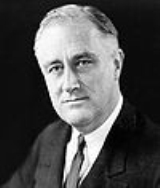
Franklin D. Roosevelt
Franklin Delano Roosevelt , also known by his initials, FDR, was the 32nd President of the United States and a central figure in world events during the mid-20th century, leading the United States during a time of worldwide economic crisis and world war...
Timeline of Events
|
1933
|
|
|||||||
|
1934
|
|
|||||||
|
1935
|
|
|||||||
|
1938
|
|
|||||||
|
1939
|
|
|||||||
|
1940
|
|
|||||||
|
1941
|
|
|||||||
|
1942
|
|
|||||||
|
1943
|
|
|||||||
|
1944
|
|
|||||||
|
1945
|
|

